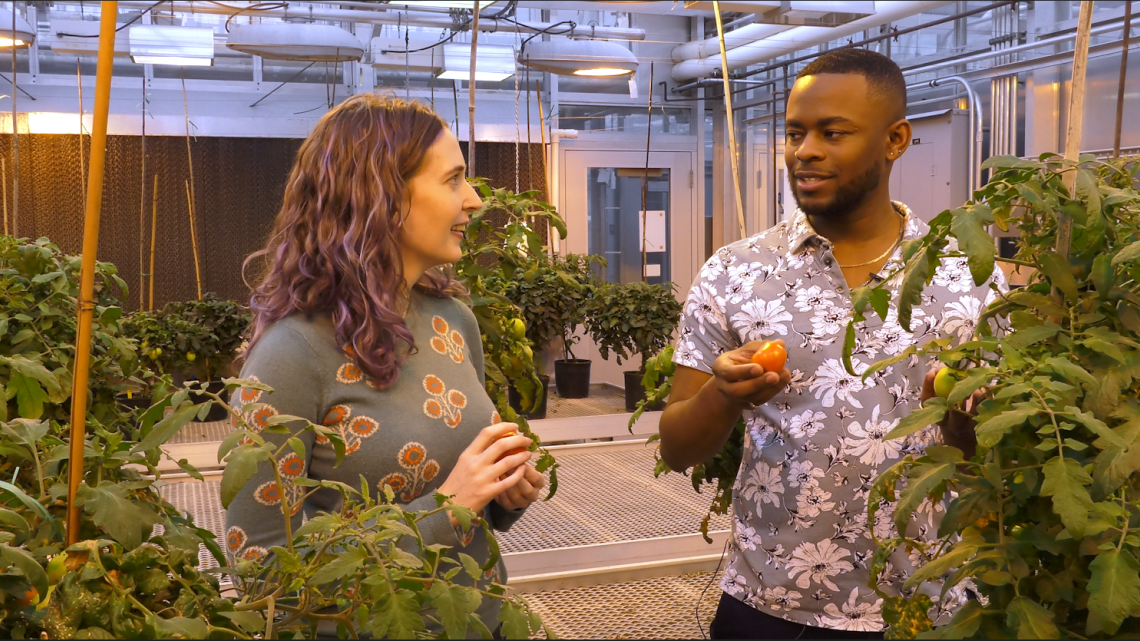
News directly from Cornell's colleges and centers
CROPPS collaboration with Science IRL demystifies research
By Krisy Gashler
Scientists at the Center for Research on Programmable Plant Systems (CROPPS) are eager to foster dialogue — both with plants and people. As part of that conversation, CROPPS has partnered with Molly Edwards ’12, the science communicator behind Science IRL (‘In Real Life’), to engage the public in demystifying the groundbreaking research on direct human communication with plants.
The first Science IRL video in a planned series about CROPPS debuted today, Sept. 14.
CROPPS, a National Science Foundation (NSF) Science and Technology Center based at Cornell University, is actively developing tools and methods to communicate with plants and soil microorganisms. This research aims to facilitate scientific breakthroughs in the transdisciplinary field of digital biology, which integrates expertise from plant sciences, engineering, computer science, and the social sciences.
For the CROPPS video, Edwards visited the Cornell campus in Ithaca, New York, where she toured Cornell and the Boyce Thompson Institute. During her visit, she delved into the efforts of scientists who are diligently working to enhance communication with plants.
Public engagement is a core component of the CROPPS mission, with a particular focus on studying social and ethical implications of digital biology. The Social and Ethical Engagement with Digital Biology (SEED) project team is working to foster conversations among the public and scientists about the goals, processes, and ethics of digital biology.
“Public engagement fosters a valuable exchange of perspectives, enabling researchers, stakeholders, and the public to learn from one another,” said Cabral Bigman-Galimore, an associate professor of communication at the University of Illinois, Urbana-Champaign and senior personnel at CROPPS.
Edwards herself is a trained scientist who gravitated towards communication as a means to make the most complex scientific concepts understandable and relatable to the public. She earned her bachelor’s degree in biology from Cornell University in 2012, followed by three years as a lab technician in New York. During her time in New York, she founded Science IRL, expanding the channel while pursuing her Ph.D. studies in plant evolution and development at Harvard University.
“I realized that my life as a scientist was really mysterious to people who aren’t scientists and I wondered if the fact that we never get to see researchers in action — in real life — could be contributing to mistrust of science in society,” Edwards said. “The channel explains science concepts, but my priority is to showcase the humanity and joy of being a scientist at work.”
Scientists featured in the video include Margaret Frank, Ph.D. ’14, assistant professor of plant biology in the School of Integrative Plant Science, in the College of Agriculture and Life Sciences; Sijin Li, assistant professor in the Smith School of Chemical and Biomolecular Engineering in the College of Engineering; Brandon Williams and Michelle Heeney, Ph.D. students in Frank’s lab; and Yinan Wu, a postdoctoral associate in Li’s lab.
In the video, Williams shows his tomato greenhouses and explains how he is studying CEP signaling (an acronym which stands for C-Terminally Encoded Peptide, and pronounced like “sep”) — the molecular communication system that plants use to monitor and adjust to nitrogen levels in soil.
“My project aims to take that to the next level,” Williams said. “What if we could translate CEP signaling into new languages? What if we could teach plants to use CEP signaling to respond to other conditions, like drought?”
In Li’s lab, Wu explains how he is working with Williams to piece together the genetic components tied to CEP signaling, drought response and fluorescence: if plants could recognize drought conditions earlier and respond with a fluorescent glow, humans could understand this plant language.
“CEP signaling, drought response, and fluorescence are all controlled by different genes, so if we want to rewire the CEP system, we will need to design a unique DNA sequence that puts all of these gene puzzle pieces together,” Wu said.
The new video produced by Science IRL is available as a resource for teaching and understanding elements of digital biology. The CROPPS team plans to use the video in its own outreach and public engagement efforts, according to Bigman-Galimore.
“At CROPPS, we want to initiate dialogs and broaden understanding of how different groups envision digital biology research and its potential impact on society,” she said. “Our social and ethical engagement research team is investigating ways public engagement might enrich the research process and lead to positive outcomes.”
Krisy Gashler is a freelance writer for the Center for Research on Programmable Plant Systems.
Media Contact
Get Cornell news delivered right to your inbox.
Subscribe
